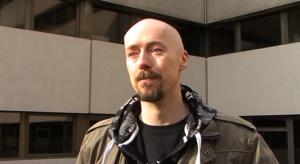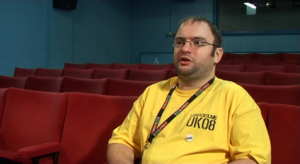 The documentary was almost entirely shot on Digital Video (DV) in widescreen PAL. Some footage from LugRadio Live USA 2008 was provided by the videographer for the event in 4:3 NTSC on DVD. A few seconds of footage from LugRadio Live 2007 was used, shot on 4:3 DV PAL.
The documentary was almost entirely shot on Digital Video (DV) in widescreen PAL. Some footage from LugRadio Live USA 2008 was provided by the videographer for the event in 4:3 NTSC on DVD. A few seconds of footage from LugRadio Live 2007 was used, shot on 4:3 DV PAL.
Most of the documentary was shot on Sony PDX-10 cameras, including all the interviews. An off-board directional microphone was used, along with a variety of Manfrotto and other tripods. The interviews were all single camera setups, conducted without additional support to operate the camera or audio equipment. Other Sony and Panasonic DV cameras were used for multi-camera shoots at the LugRadio Live events.
Some photos were sourced from the LugRadio community and presenters. Others were taken during the LugRadio Live USA 2008 trip on a Canon EOS 350D with a 28-135mm IS EF-S lens.
 The documentary was produced using Free and Open Source Software running on Ubuntu Linux. DV footage was captured using Kino and edited in kdenlive, with various effects applied within that application. The documentary was produced in segments, with the audio from each track in each segment exported separately for mixing. The audio was mixed in Ardour using several LADSPA plugins before being re-imported into kdenlive and synced with the video. Captions were created in inkscape using a button from the Open Clip Art project as a starting point, before being rendered as PNG files with a transparent background. Titles were generated in the GIMP. The still photos were converted to “pan and zoom” using stills2dv. The segments were assembled in a final project within kdenlive before being converted to a number of formats using the built-in export features of kdenlive, ffmpeg and ffmpeg2theora.
The documentary was produced using Free and Open Source Software running on Ubuntu Linux. DV footage was captured using Kino and edited in kdenlive, with various effects applied within that application. The documentary was produced in segments, with the audio from each track in each segment exported separately for mixing. The audio was mixed in Ardour using several LADSPA plugins before being re-imported into kdenlive and synced with the video. Captions were created in inkscape using a button from the Open Clip Art project as a starting point, before being rendered as PNG files with a transparent background. Titles were generated in the GIMP. The still photos were converted to “pan and zoom” using stills2dv. The segments were assembled in a final project within kdenlive before being converted to a number of formats using the built-in export features of kdenlive, ffmpeg and ffmpeg2theora.
The music on the show was from Jono Bacon’s Severed Fifth project. The LugRadio theme tune, Jack’s Playing Ball, is also by Jono. The sound effect was from the Freesound project. The narration was recorded onto a Zoom H4n using a condensor microphone and pop filter.